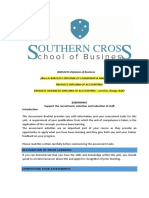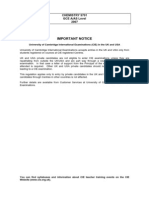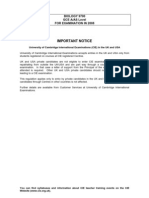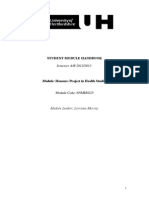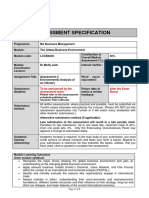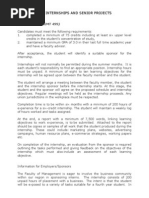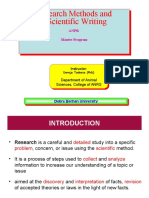Biology Project-Report General Assessment Information
Biology Project-Report General Assessment Information
Uploaded by
CarlCopyright:
Available Formats
Biology Project-Report General Assessment Information
Biology Project-Report General Assessment Information
Uploaded by
CarlOriginal Title
Copyright
Available Formats
Share this document
Did you find this document useful?
Is this content inappropriate?
Copyright:
Available Formats
Biology Project-Report General Assessment Information
Biology Project-Report General Assessment Information
Uploaded by
CarlCopyright:
Available Formats
Biology
Project–report
General assessment information
This pack contains general assessment information for
centres preparing candidates for the project–report
Component of Advanced Higher Biology Course assessment.
It must be read in conjunction with the specific assessment
task for this Component of Course assessment which may
only be downloaded from SQA’s designated secure website
by authorised personnel.
This edition: October 2017 (version 1.2)
The information in this publication may be reproduced to support SQA
qualifications. This publication must not be reproduced for commercial or trade
purposes. This material is for use by assessors.
© Scottish Qualifications Authority 2017
Contents
Introduction 1
What this assessment covers 2
Assessment 3
General Marking Instructions 6
Introduction
This is the general assessment information for Advanced Higher Biology project–
report.
This project–report is worth 30 marks out of a total of 120 marks available for
this Course. The Course will be graded A–D.
Marks for all Course Components are added up to give a total Course
assessment mark which is then used as the basis for grading decisions.
This is one of two Components of Course assessment. The other Component is a
question paper.
The assessment task will be set and externally marked by SQA and conducted in
centres under the conditions specified by SQA.
This document describes the general requirements for the assessment of the
project–report Component for this Course. It gives general information and
instructions for assessors.
It must be read in conjunction with the assessment task for this Component of
Course assessment.
Equality and inclusion
This Course assessment has been designed to ensure that there are no
unnecessary barriers to assessment. Assessments have been designed to
promote equal opportunities while maintaining the integrity of the
qualification.
For guidance on assessment arrangements for disabled candidates and/or those
with additional support needs, please follow the link to the Assessment
Arrangements web page: www.sqa.org.uk/sqa/14977.html
Guidance on inclusive approaches to delivery and assessment in this Course is
provided in the Course/Unit Support Notes.
Advanced Higher Biology: project–report — general assessment information 1
What this assessment covers
This project–report is worth 30 marks out of a total of 120 marks available for
this Course.
The assessment will assess the skills, knowledge and understanding specified
for the project–report in the Course Assessment Specification. These are:
extending and applying knowledge of biology to new situations, interpreting
and analysing information to solve complex problems
planning and designing biological experiments/investigations, using
reference material and including risk assessments, to test a hypothesis or to
illustrate particular effects
recording systematic detailed observations and collecting data
selecting information from a variety of sources and presenting detailed
information appropriately, in a variety of forms
processing and analysing biological information (using calculations,
significant figures and units, where appropriate)
making reasoned predictions and generalisations from a range of
evidence/information
drawing valid conclusions and giving explanations supported by
evidence/justification
critically evaluating experimental procedures by identifying sources of
error, suggesting and implementing improvements
drawing on knowledge and understanding of biology to make accurate
statements, describe complex information, provide detailed explanations
and integrate knowledge
communicating biological findings/information fully and effectively
analysing and evaluating scientific publications and media reports
Advanced Higher Biology: project–report — general assessment information 2
Assessment
Purpose
The purpose of this assessment is to generate evidence for the Added Value of
this Course by means of a project–report.
Assessment overview
Assessment should take place when the candidates are ready to be assessed.
In this assessment the candidate will carry out an in-depth investigation of a
biology topic. The topic will be chosen by the candidate. The candidate must
discuss the selection of possible topics with their assessor to ensure that time is
not wasted on researching topics that are unsuitable. The candidate will work
individually to investigate/research the underlying biology of the topic. This is
an open-ended task which may involve a significant part of the work being
carried out without supervision.
The project–report offers challenge by requiring skills, knowledge and
understanding to be applied in a context that is one or more of the following:
unfamiliar
familiar but investigated in greater depth
integrating a number of familiar contexts
Prior to starting this assessment candidates should have started a biology
investigation. This should normally be as part of the Investigative Biology Unit.
In that Unit, candidates are required to plan and carry out a biology
investigation. Candidates should keep a record of their work as this may form
the basis of their project–report. This record should include details of their
research, experiments and recorded data.
The project–report submitted to SQA must have a logical structure and must be
clear, concise and easy to read.
The project-report should be between 3000 and 3600 words in length excluding
the title page, contents page, tables, graphs, diagrams, calculations,
references, acknowledgements and any appendices. The word count should be
submitted with the project–report. If the word count exceeds the maximum by
10%, a 3 mark penalty will be applied. It should be written in the past tense
and the impersonal voice should be used.
Detailed advice on the content of the project–report is given in the Advanced
Higher Biology Project Assessment Task.
Advanced Higher Biology: project–report — general assessment information 3
Assessment conditions
Assessors must exercise their professional responsibility in ensuring that
evidence submitted by a candidate is the candidate’s own work.
This assessment will be carried out over a period of time. Candidates should
start at an appropriate point in the Course. This will normally be after they
have started work on the Units in the Course.
Evidence which meets the requirements of this Component of Course
assessment will be between 3000 and 3600 words. The word count should be
submitted with the project–report. If the word count exceeds the maximum by
10%, a 3 mark penalty will be applied.
There are no restrictions on the resources to which candidates may have
access.
Candidates must undertake the assessment, whatever the nature,
independently. However, reasonable assistance may be provided prior to the
formal assessment process taking place. The term ‘reasonable assistance’ is
used to try to balance the need for support with the need to avoid giving too
much assistance.
Coursework in Advanced Higher may involve learners undertaking a larger
amount of autonomous work without close supervision than they have
previously undertaken. Assessors may provide guidance and support as part of
the normal teaching and learning process. However, assessors should not adopt
a directive role or provide specific advice on how to re-phrase, improve
responses or provide model answers.
Assessor comments on the selection of a topic are appropriate before the
candidate starts the task.
The requirements of the project–report should be made clear to candidates at
the outset.
The project–report will be conducted under some supervision and control. This
means that although candidates may complete part of the work outwith the
learning and teaching setting, assessors should put in place processes for
monitoring progress and ensuring that the work is the candidate’s own and that
plagiarism has not taken place.
Assessors should put in place mechanisms to authenticate candidate evidence.
For example:
regular checkpoint/progress meetings with candidates
short spot-check personal interviews
checklists which record activity/progress
photographs, film or audio evidence
Advanced Higher Biology: project–report — general assessment information 4
Evidence to be gathered
The following candidate evidence is required for this assessment:
a project–report
The project–report will be submitted to SQA, within a given timeframe, for
marking. The same project–report cannot be submitted for more than one
subject.
Advanced Higher Biology: project–report — general assessment information 5
General Marking Instructions
In line with SQA’s normal practice, the following general Marking Instructions
are addressed to the marker. They will also be helpful for those preparing
candidates for Course assessment.
Evidence will be submitted to SQA for external marking.
All marking will be quality assured by SQA.
General Marking Principles for Advanced Higher Biology project–report
This information is provided to help you understand the general principles you
must apply when marking candidate responses to this project–report. These
principles must be read in conjunction with the Detailed Marking Instructions,
which identify the key features required in candidate responses.
(a) Marks for each candidate response must always be assigned in line with
these General Marking Principles and the Detailed Marking Instructions
for this assessment.
(b) Marking should always be positive. This means that, for each candidate
response, marks are accumulated for the demonstration of relevant
skills, knowledge and understanding: they are not deducted from a
maximum on the basis of errors or omissions.
Advanced Higher Biology: project–report — general assessment information 6
Overview of Marking Instructions
Assessment category and criteria Marks
Abstract
a brief abstract stating the main aim(s) and overall finding(s) of 1
the investigation (1)
Introduction
clear statement of aim(s) together with relevant 1
hypotheses/questions
account of underlying biology is coherent and relevant to aim(s) 4
biological terms/ideas are clear and accurate
biological terms/ideas are at an appropriate depth
biological importance is explained/justified
(5)
Procedures
appropriate to aim(s) 1
procedures described clearly in sufficient detail to allow the 2
investigation to be repeated
appropriate controls 1
control of variables 1
sample size 1
1
independent replicates
2
complexity, creativity, accuracy and modification
(9)
Results
relevant to aim(s) of the investigation 1
raw data recorded and within limits of accuracy of measurement 1
appropriate presentation 1
quality of presentation 1
presentation summarises overall results 1
1
a clear statement of any trends (or the absence of any trend),
shown by the data, is given
(6)
Discussion (conclusion(s) and evaluation)
conclusion(s) relate to aim(s) of the investigation 1
conclusion(s) is/are valid 1
evaluation of procedures includes comment as appropriate on: 2
— accuracy/sources of error in measurement
— adequacy of replication/sampling
— adequacy of controls
— positive and/or negative aspects of investigation design
— solutions to problems and modifications to procedures
evaluation of results includes as appropriate: 3
— analysis of results
— interpretation of results
— critical and scientific discussion of significance of finding(s) (7)
Presentation
appropriate structure, including informative title, contents page 1
and page numbers
references cited in the text and references listed using an 1
established referencing system, acknowledgements, where
appropriate (2)
Total marks 30
Advanced Higher Biology: project–report — general assessment information 7
Detailed Marking Instructions for the project–report
These Detailed Marking Instructions provide the basis on which the General Marking Principles should be applied. The following table shows
how the 30 marks are allocated to each of the categories against which the evidence will be assessed. The project–report should be between
3000 and 3600 words in length. The word count should be submitted with the project–report. If the word count exceeds the maximum by
10%, a 3 mark penalty will be applied.
Category Expected response Max Additional guidance
mark
Abstract a brief abstract stating main aim(s) 1 A brief abstract must immediately follow the contents page and should
and overall finding(s)/conclusion(s) of be under a separate heading. The ‘abstract’ must contain a clear
the investigation statement of the main aims(s) and overall finding(s)/conclusion(s) of the
investigation and must be separate from and placed before the
‘introduction’.
The overall finding(s) must be consistent with the conclusion(s) given in
the ‘discussion’ and should relate to the aim(s).
Introduction clear statement of aim(s) together 5 Aim(s) and hypotheses/questions must be explicitly stated.
with relevant hypotheses/questions (1)
account of underlying biology is The background theory must be relevant; ie the information must be
coherent and relevant to aim(s) coherent and link clearly to the aim(s).
Advanced Higher Biology: project–report — general assessment information 8
Category Expected response Max Additional guidance
mark
Introduction The candidate should provide enough information in this section to
(continued) allow an appropriate level of analysis, interpretation or discussion of
results.
biological terms/ideas are explained The biological importance is explained/justified. The candidate must
clearly and accurately address issues that explain why the investigation is worth doing. An
investigation need not be justified in terms of an immediate benefit to
biological terms/ideas are at an humans or the environment. It could be one seeking to extend
appropriate depth knowledge or to replicate and confirm other researchers’ findings.
This is treated in a holistic way so that an introduction weak in all four
components could still attain marks. It is an opportunity to give marks
biological importance is for ‘quality’. Professional judgement should be used, eg if only two
explained/justified (4) points were covered and done well, then 2 marks should be awarded. If
all four points were covered but with omissions or inaccuracies, then
2 marks could still be appropriate.
Allow minor errors but not if fundamental to the biology behind the
investigation.
Copying of lengthy sections of original text should not be rewarded.
Candidates should use their own words wherever possible.
Downloading directly from the internet or copying directly from books
may suggest that the candidate has not understood the biology involved
and will be considered as plagiarism. Where the vast majority is
believed to have been copied verbatim then the candidate is not
demonstrating understanding and should be marked accordingly.
Advanced Higher Biology: project–report — general assessment information 9
Category Expected response Max Additional guidance
mark
Introduction Complicated diagrams copied and pasted from an internet source are
(continued) acceptable. Where their source is acknowledged, these cannot count as
the cited references.
Procedures appropriate to aim(s) (1) 9 In broad terms, the procedure(s) should allow the aim(s) to be achieved.
If there is no stated aim this mark may still be awarded if the aim is
obvious from the title of the project-report.
procedure(s) described clearly in
sufficient detail to allow the At least one procedure must be clearly described. If more than one
investigation to be repeated (2) procedure is carried out, then the major one used in the investigation
must be described. The procedure should be described well enough for
another competent Advanced Higher Biology candidate to be able to
repeat the procedure from the description.
2 marks can be awarded if a full and clear description of all stages in
the procedure(s) is provided. 1 mark can still be awarded if some minor
details are omitted but not where an essential part of the procedure is
omitted.
The project–report should be written in the past tense and impersonal
voice. If the project–report is not written in past tense and impersonal
voice, eg if written as a set of instructions in the imperative voice then
a maximum of 1 mark can be given for ‘procedures’. Consider use of
first person on one occasion only as a minor error.
Advanced Higher Biology: project–report — general assessment information 10
Category Expected response Max Additional guidance
mark
Procedures Bulleted/numbered points are only acceptable if statements are in
(continued) sentences and are meaningful and coherent, ie must make sense if
numbers or bullet points were to be removed, but must not be a list of
instructions.
Safety issues should only be considered if they have a bearing on
validity/reliability etc.
appropriate controls (1) Appropriate controls should be identified. If no controls are used (eg if
the relative effect of two treatments is being compared), then
justification must be given.
control of variables (1) Confounding variables that affect the validity have been controlled.
sample size (1) Sample size is appropriate /adequate for the procedure. This will vary
according to the type of investigation. In some investigations, simple
duplication may constitute a minimum requirement.
independent replicates (1) Evidence of independent replicates. A separate data set must be
obtained, eg by repeating the experiment on a separate occasion or by
sampling from a different location. A replicate set of data recorded
from the same subjects to establish baseline variation prior to
treatment is acceptable.
Advanced Higher Biology: project–report — general assessment information 11
Category Expected response Max Additional guidance
mark
Procedures complexity, creativity, accuracy and Combinations of the following elements, allow 2 marks to be awarded:
(continued) modification (2) — complexity
— creativity/originality
— appropriate accuracy
— pilot study or experiments based on previous findings
A complex protocol or difficult/unfamiliar techniques have been used
(eg use of colorimeter/ spectrophotometer or aseptic microbial
techniques may be sufficient to award here).
A novel way of using a simple procedure has been developed.
Evidence of originality/creativity in the design of the investigation.
Evidence of a pilot study that was used to test/develop procedures.
Procedures/apparatus used are able to deliver an appropriate level of
accuracy to test the aim(s).
Results relevant to the aim(s) of the 6
investigation (1)
raw data recorded and within limits of Extensive raw data may be recorded in an appendix. Average results
accuracy of measurement (1) must not have an excessive number of decimal places or a claimed
degree of accuracy greater than that of the raw data.
appropriate presentation (1) Raw and processed results must be presented clearly and concisely in
appropriate formats. The graphs and tables are appropriate for linking
the data and the aim(s).
Advanced Higher Biology: project–report — general assessment information 12
Category Expected response Max Additional guidance
mark
Results quality of presentation (1) The quality of presentation is adequate, including
(continued) headings/units/scales/labels/clarity. Computer generated graphs may
require scientific formatting to ensure that axes and scales are
appropriate and are of adequate quality.
Calculations must be correct; minor errors should not be penalised.
presentation summarises overall Data presented should summarise the overall results. Where raw data
results (1) are presented in an appendix, any graph of processed data must be
supported by an appropriate table in the body of the project–report.
a clear statement of any trends (or the Clear descriptions are given of trends and patterns (or their obvious
absence of any trend), shown by the absence) in results tables or graphs.
data, is given (1)
Discussion conclusion(s) relate to aim(s) of the 7 Comments/inferences on perceived trends should be relevant to the
(conclusion(s) investigation (1) aim(s) and supported by data in the project–report. If the mark for
and trends (‘results’ section) has already been awarded, additional credit
evaluation) cannot be gained here by simple repetition.
conclusion(s) is/are valid (1) A valid conclusion(s) is/are stated. Validity depends on an appropriate
method, adequate control of variables and evidence of repeatable
results from sufficient replication and sample size.
Advanced Higher Biology: project–report — general assessment information 13
Category Expected response Max Additional guidance
mark
Discussion evaluation of procedures (2) 2 marks may be awarded for an evaluation that considers the essential
(conclusion(s) includes comment, as appropriate, on: aspects of experimental design that were required for valid conclusions
and — accuracy/sources of error in and were planned into the investigation.
evaluation) measurement A maximum of 1 mark should be awarded if a major aspect of the
(continued) — adequacy of replication/sampling procedure(s) that compromises validity has not been considered during
— adequacy of controls or recognition the course of the investigation; eg the inadequacy of sample size, lack
of the effects of confounding of independent replicates, lack of controls or failure to control a
confounding variable.
variables
— positive and/or negative aspects of
investigation design
— solutions to problems and
modifications to procedures
evaluation of results (3) Variation in results obtained from replicates and the degree of accuracy
includes, as appropriate: of results should be discussed. Credit may be given for attempts to carry
— analysis of results out appropriate statistical evaluation including use of error bars.
— interpretation of results The validity, reliability and significance of the results should be
— critical and scientific discussion of discussed by considering the role of controls and the variability of
significance of finding(s) replicates.
Discussion here is expected to be critical/analytical.
In discussing the investigation finding(s) as a whole, candidates should
make effective use of their biological knowledge, drawing particularly
on the background they presented in the ‘introduction’.
Advanced Higher Biology: project–report — general assessment information 14
Category Expected response Max Additional guidance
mark
Presentation appropriate structure, including 2 The project–report structure should be easy to follow. The title must
informative title, contents page and include two of ‘Input’, ‘Outcome’ and ‘Process/Context/Organism’, eg
page numbers (1) ‘Effect of garlic on lipase activity’ is acceptable; ‘Pollution and plants’
is not.
A contents page and structure are essential — the contents page must
show page numbers and the pages throughout the project–report must
be numbered. Occasional missing page numbers (eg on hand-drawn
graphs) should not be penalised.
references cited in the text and At least three references must be cited correctly in the main body of
references listed using an established the project–report and the same ones also listed correctly at the end of
referencing system, the project–report. Any additional references cited or listed incorrectly
acknowledgements, where appropriate should not be penalised. The Harvard or Vancouver system of
(1) referencing must be used. References may include books,
journals/periodicals and websites and should be listed at the end of the
project–report.
Note that it must not be the same book/website referred to on two or
three occasions even if the reference is to different page numbers. The
candidate must find at least three references, ideally at the planning
stage.
Total marks 30
Advanced Higher Biology: project–report — general assessment information 15
Administrative information
Published: October 2017 (version 1.2)
History of changes
Version Description of change Authorised by Date
1.1 Detailed Marking Instructions Qualifications September
updated to further exemplify Manager 2016
Marking Instructions.
1.2 Detailed Marking Instructions Qualifications October
updated to provide further clarity. Manager 2017
Security and confidentiality
This document can be used by practitioners in SQA approved centres for the
assessment of National Courses and not for any other purpose.
Copyright
This document may be reproduced in whole or in part for assessment purposes
provided that no profit is derived from reproduction and that, if reproduced in
part, the source is acknowledged. If it needs to be reproduced for any purpose
other than assessment, it is the centre’s responsibility to obtain copyright
clearance.
Re-use for alternative purposes without the necessary copyright clearance may
constitute copyright infringement.
© Scottish Qualifications Authority 2017
Advanced Higher Biology: project–report — general assessment information 16
You might also like
- CHCAGE002 Implement Falls Prevention Strategies: Mode OneDocument26 pagesCHCAGE002 Implement Falls Prevention Strategies: Mode OnemaxsalNo ratings yet
- NRS-493 Individual Success Plan: Complete Contact InformationDocument9 pagesNRS-493 Individual Success Plan: Complete Contact Informationlaura zohar0% (1)
- Excerpt: "IGNORANCE: How It Drives Science" by Stuart FiresteinDocument9 pagesExcerpt: "IGNORANCE: How It Drives Science" by Stuart Firesteinwamu885100% (1)
- Uclan Coursework Assessment Brief: Performance MeasurementDocument5 pagesUclan Coursework Assessment Brief: Performance MeasurementOlumide LadegNo ratings yet
- 50 Samples of English Paragraph WritingDocument24 pages50 Samples of English Paragraph WritingKiều Linh75% (8)
- AHCATBiologyDocument32 pagesAHCATBiologyiidc63913No ratings yet
- Physics N5 Assignment SheetDocument31 pagesPhysics N5 Assignment SheetalexhqmondNo ratings yet
- Model Answers BSBLDR402 - V1 - Feb 2016Document32 pagesModel Answers BSBLDR402 - V1 - Feb 2016maxsalNo ratings yet
- Quality Syllabus 1444 H Prof - AboshaiqahDocument4 pagesQuality Syllabus 1444 H Prof - AboshaiqahAbeer MustafaNo ratings yet
- 23 24 Ansac Criteria FinalDocument28 pages23 24 Ansac Criteria Finalamare ayeleNo ratings yet
- CHCCCS025 Model Answers - V1.1 - March 2017Document34 pagesCHCCCS025 Model Answers - V1.1 - March 2017maxsal100% (2)
- Model Answers CHCLEG003 - V1.1 - March 2017Document29 pagesModel Answers CHCLEG003 - V1.1 - March 2017maxsalNo ratings yet
- Acob - Module 9.curriculum AssessmentDocument7 pagesAcob - Module 9.curriculum AssessmentJoy AcobNo ratings yet
- n5 Cat ChemistryDocument32 pagesn5 Cat Chemistrykanzahaya7No ratings yet
- Medical LaboratoryDocument34 pagesMedical Laboratorytsion07utNo ratings yet
- BSBHRM405 AssessmentDocument52 pagesBSBHRM405 AssessmentAli Raza Mashhadi100% (1)
- Academic Program Assessment Handbook: Guidelines DocumentDocument50 pagesAcademic Program Assessment Handbook: Guidelines DocumentHinaNo ratings yet
- The Testing ProgramRUBY C. BAGON MAED EMDocument11 pagesThe Testing ProgramRUBY C. BAGON MAED EMFloreza Mae MengulloNo ratings yet
- Surgical NursingDocument24 pagesSurgical NursingKadir IliyaasNo ratings yet
- Introduction of ABET To CE 203Document45 pagesIntroduction of ABET To CE 203Saciid LaafaNo ratings yet
- Subject Overview ACC3044 (March 2014)Document6 pagesSubject Overview ACC3044 (March 2014)Gurrajvin SinghNo ratings yet
- 9701 Chem 2007 SyllabusDocument70 pages9701 Chem 2007 Syllabuskenya11No ratings yet
- HigherCATPhysicsDocument31 pagesHigherCATPhysicsteenaajith918No ratings yet
- Important Notice: BIOLOGY 9700 GCE A/AS Level For Examination in 2008Document44 pagesImportant Notice: BIOLOGY 9700 GCE A/AS Level For Examination in 2008Hasnain HossainNo ratings yet
- ED1 2011 Exam-Report-June PDFDocument12 pagesED1 2011 Exam-Report-June PDFKevin Raman100% (2)
- 6NMH0225 Handbook 2012-2013Document21 pages6NMH0225 Handbook 2012-2013shayziaNo ratings yet
- BSBSUS201 Student Assessment V2.0Document13 pagesBSBSUS201 Student Assessment V2.0Bilal50% (2)
- Internal Assessment Guide 2012 Physics Reduced PDFDocument198 pagesInternal Assessment Guide 2012 Physics Reduced PDFRaisul IslamNo ratings yet
- Project GuidelinesDocument10 pagesProject GuidelinesnasiabroNo ratings yet
- 2023-24 AP0708 Assessment 3 Brief - Project ReportDocument14 pages2023-24 AP0708 Assessment 3 Brief - Project ReportArani NavaratnarajahNo ratings yet
- Unit Guide ACCG350 2016 S1 EveningDocument17 pagesUnit Guide ACCG350 2016 S1 EveningSameer SharmaNo ratings yet
- BUSC511Document12 pagesBUSC511narindrsingh.19No ratings yet
- HSM200 Assessment Guide Draft Version 6 Final 21.05.22Document7 pagesHSM200 Assessment Guide Draft Version 6 Final 21.05.22Moreen WachukaNo ratings yet
- M&E Project Report Guide - Updated 2020Document14 pagesM&E Project Report Guide - Updated 2020Tanaka chindakudaNo ratings yet
- MG Empowering People With A Disability (ID 97346)Document44 pagesMG Empowering People With A Disability (ID 97346)amir abbasi100% (1)
- AG-Student-CHCEDU002 Plan Health Promotion and Com Intervention V2Document21 pagesAG-Student-CHCEDU002 Plan Health Promotion and Com Intervention V2Ambika SuwalNo ratings yet
- (Approved) Ugb368 Mrp-Ia-Mdist Ay2023-24Document7 pages(Approved) Ugb368 Mrp-Ia-Mdist Ay2023-24zumradibragimova55No ratings yet
- Unit - Guide - HRM 107 - 2018 - S1 EveningDocument12 pagesUnit - Guide - HRM 107 - 2018 - S1 EveningVictoriaNo ratings yet
- Assignment 2 2023-24 - DAT7305 Health Informatics (May Start)Document10 pagesAssignment 2 2023-24 - DAT7305 Health Informatics (May Start)Lilian MutukuNo ratings yet
- BSBPMG522 Student Assessment V4.0Document12 pagesBSBPMG522 Student Assessment V4.0Jenny YipNo ratings yet
- LCBB4005 - Global Business Environment Assessment 2Document9 pagesLCBB4005 - Global Business Environment Assessment 2Guzi OvidiuNo ratings yet
- CHCCCS019 Marking Guide - AGE (ID 126780)Document33 pagesCHCCCS019 Marking Guide - AGE (ID 126780)faridessamNo ratings yet
- KM-05,-Learner GuideDocument50 pagesKM-05,-Learner GuidehamidyalcouyeNo ratings yet
- Assessment Brief MSC Dissertation 2023 - TaggedDocument17 pagesAssessment Brief MSC Dissertation 2023 - Taggedcrsamsung9No ratings yet
- Plant and Soil Science SGDocument16 pagesPlant and Soil Science SGjanemugecha060No ratings yet
- CHCECE030 Inclusion Diversity 1 PDFDocument25 pagesCHCECE030 Inclusion Diversity 1 PDFbellahuynh0205No ratings yet
- UNIT 6 Research ProjectDocument4 pagesUNIT 6 Research Projectchandni0810No ratings yet
- Assessment Brief Intermediate Placement Viva 2019-20-1Document4 pagesAssessment Brief Intermediate Placement Viva 2019-20-1Walaa AlbeladiNo ratings yet
- DEVECO MSC Development EconomicsDocument7 pagesDEVECO MSC Development EconomicsPhuNo ratings yet
- Internal Assessment Guide 2012 Physics Reduced PDFDocument198 pagesInternal Assessment Guide 2012 Physics Reduced PDFLegacyGrade1280% (5)
- Curriculum Review basic TasksDocument6 pagesCurriculum Review basic TasksawokegoshiNo ratings yet
- NUR 190 Syllabus SU24Document7 pagesNUR 190 Syllabus SU24bmurerNo ratings yet
- Department of Interdisciplinary StudiesDocument14 pagesDepartment of Interdisciplinary StudiesBautista OrlNo ratings yet
- BB A Internships Applied ProjectsDocument4 pagesBB A Internships Applied ProjectsahmedalyaniNo ratings yet
- Disorder Case Study Assignment Brief 23-24Document7 pagesDisorder Case Study Assignment Brief 23-24hussymian06No ratings yet
- 3009sem.6001sem CW1Document7 pages3009sem.6001sem CW1hzh2577848712No ratings yet
- HS4205ADocument11 pagesHS4205ARachel PizzoniaNo ratings yet
- Unit - Guide - ACCG3040 - 2022 - Session 1, in Person-Scheduled-Weekday, North RydeDocument11 pagesUnit - Guide - ACCG3040 - 2022 - Session 1, in Person-Scheduled-Weekday, North RydeThanh NgânNo ratings yet
- RIICWD509E Student Workbook 1 MAF PDFDocument43 pagesRIICWD509E Student Workbook 1 MAF PDFBirendra GCNo ratings yet
- Sgvu Project Work For Mba PDFDocument5 pagesSgvu Project Work For Mba PDFParbat DahalNo ratings yet
- N 620 Professional Aspects and Leadership For Nurse Anesthesia PracticeDocument18 pagesN 620 Professional Aspects and Leadership For Nurse Anesthesia Practiceapi-267840127No ratings yet
- Information Security Management Professional based on ISO/IEC 27001 Courseware revised Edition– EnglishFrom EverandInformation Security Management Professional based on ISO/IEC 27001 Courseware revised Edition– EnglishNo ratings yet
- Future Design of Accessibility in Games - A Design Vocabulary - ScienceDirectDocument16 pagesFuture Design of Accessibility in Games - A Design Vocabulary - ScienceDirectsulaNo ratings yet
- The Search in Saiva Scriptures For Meaning in Tantric Ritual-Judit TörzsökDocument32 pagesThe Search in Saiva Scriptures For Meaning in Tantric Ritual-Judit Törzsökitineo2012No ratings yet
- 找到最好的作业帮助Document10 pages找到最好的作业帮助g69vq34n100% (1)
- Jurisprudence Instruction Manual 3 7 2020 AmendedDocument100 pagesJurisprudence Instruction Manual 3 7 2020 AmendedDiana WangamatiNo ratings yet
- 1998 Widdowson Context, Community, and Authentic LanguageDocument13 pages1998 Widdowson Context, Community, and Authentic Languageacie600100% (1)
- Criticim Qualification of The CriticDocument5 pagesCriticim Qualification of The CriticRaja Shujat100% (1)
- Generative Mesh ModelingDocument303 pagesGenerative Mesh ModelingcduretNo ratings yet
- Ed4a Profed QuizDocument2 pagesEd4a Profed QuizNABUA MARY CRYSTALLINE S.No ratings yet
- 교과교수법 JournalDocument5 pages교과교수법 Journalkyhw2dgfsvNo ratings yet
- Implicit and Explicit Motives Influence AccessibilityDocument10 pagesImplicit and Explicit Motives Influence AccessibilityPersephona13No ratings yet
- Burte - 2008 - Space For EngagementDocument26 pagesBurte - 2008 - Space For EngagementGiorgio ManfrèNo ratings yet
- Meleis (1997) .Document20 pagesMeleis (1997) .Basil Hameed AmarnehNo ratings yet
- Key Issues in The New KnowledgeDocument293 pagesKey Issues in The New KnowledgeSol LapNo ratings yet
- Test Bank: C. Behavioral Research On Human DevelopmentDocument13 pagesTest Bank: C. Behavioral Research On Human Developmenthallo Bro0% (1)
- Thoilga, 1 and Ib: L'Tiu"""Pii)Document479 pagesThoilga, 1 and Ib: L'Tiu"""Pii)Konchok nyimaNo ratings yet
- Topic Wise Cabinet Secretariat Deputy Field Officer Syllabus 2019Document3 pagesTopic Wise Cabinet Secretariat Deputy Field Officer Syllabus 2019brain boosterNo ratings yet
- Constructivism & CceDocument11 pagesConstructivism & CceamanNo ratings yet
- CO 4th Quarter Organize Data in Tabular FormDocument3 pagesCO 4th Quarter Organize Data in Tabular FormDina Enriquez AbayonNo ratings yet
- Zhang, E. D., & Yu, S. (2024). ‘I Am Not Omniscient’ an Autoethnography Inquiry Into a Novice L2 Teacher’s Implementation of Digital Multimodal Composing. Computer Assisted Language Learning, 1–29.Document30 pagesZhang, E. D., & Yu, S. (2024). ‘I Am Not Omniscient’ an Autoethnography Inquiry Into a Novice L2 Teacher’s Implementation of Digital Multimodal Composing. Computer Assisted Language Learning, 1–29.Johnny WenNo ratings yet
- Mastery of Life PDFDocument28 pagesMastery of Life PDFAmy ValenzuelaNo ratings yet
- Military Cover LetterDocument8 pagesMilitary Cover Letterfsjqj9qh100% (1)
- Chapter 3Document31 pagesChapter 3Abreham AwokeNo ratings yet
- Holloway & Tondres 2003 Grounded TheoryDocument13 pagesHolloway & Tondres 2003 Grounded TheoryMariaNo ratings yet
- Higher EducationDocument4 pagesHigher EducationShubam SharmaNo ratings yet
- Internship Report of Parwaz Engineering (Fan) Company LimitedDocument38 pagesInternship Report of Parwaz Engineering (Fan) Company Limitedbbaahmad89100% (1)
- Research Methods & Scientific WritingDocument83 pagesResearch Methods & Scientific Writinggeletaw mitaw100% (1)
- Studies / Studien: Civil Society, Public Sphere, and Justice in The Philosophy of Iris Marion YoungDocument18 pagesStudies / Studien: Civil Society, Public Sphere, and Justice in The Philosophy of Iris Marion YoungTina HorvatNo ratings yet
- PR1 Lesson 2Document7 pagesPR1 Lesson 2Ruel AcostaNo ratings yet















